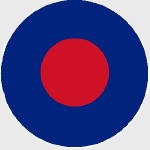Corgi AA34109 RAF Blackburn Buccaneer S.Mk 2B Strike Aircraft - No. 208 Squadron, Nellis AFB, NV, Red Flag, 1977 (1:72 Scale)
"In the future, war will be waged essentially against the unarmed populations of the cities and great industrial centers."
- Italian General Giulio Douhet
 The Blackburn Buccaneer was a British low-level strike aircraft with nuclear weapon capability serving with the Royal Navy and the Royal Air Force between 1962 and 1994, including service in the 1991 Gulf War. Designed and initially produced by Blackburn Aircraft it was later known as the Hawker Siddeley Buccaneer when Blackburn became a part of the Hawker Siddeley group.
The Blackburn Buccaneer was a British low-level strike aircraft with nuclear weapon capability serving with the Royal Navy and the Royal Air Force between 1962 and 1994, including service in the 1991 Gulf War. Designed and initially produced by Blackburn Aircraft it was later known as the Hawker Siddeley Buccaneer when Blackburn became a part of the Hawker Siddeley group.
The Buccaneer was a mid-wing, twin-engine monoplane with a crew of two seated in tandem under a sliding canopy. To meet the demands of the specification, the Buccaneer featured a number of advanced design features. The fuselage was area ruled; meaning it was designed to reduce drag at transonic speeds. This gives rise to the characteristic curvy "Coke bottle" shape. It featured a variable incidence tailplane that could be trimmed to suit the particular requirements of low-speed handling or high-speed flight. At the low-levels and high speeds traditional bomb bay doors could not be opened safely into the air stream, therefore doors were developed that rotated into the fuselage to expose the payload. This was also useful in assisting ground-level access.
The small wing of the Buccaneer was suited to high-speed flight at low level. Such a wing, however, did not generate the lift that was essential for low-speed carrier operations. Therefore, the wing and horizontal stabiliser were "blown" by bleeding compressor gas from the engine through surface vents. A consequence of the blown wing was that the engines were required to run at high power for low-speed flight in order to generate sufficient compressor gas for blowing. Blackburn's solution to this situation was to provide a large air brake. The tail cone was formed from two leaves that could be hydraulically opened into the airstream to decelerate the aircraft. The nose cone and radar antenna could also be swung around by 180° to reduce the length of the aircraft in the carrier hangar. This feature was particularly important as contemporary British aircraft carriers were small.
Pictured here is a 1:72 scale replica of a RAF Blackburn Buccaneer S.Mk 2B strike aircraft that was attached to No. 208 Squadron, which participated in the Red Flag exercises conducted at Nellis AFB, during 1977.
Sold Out!
Dimensions:
Wingspan: 7-1/4 inches
Length: 10-1/2 inches
Release Date: February 2010
Historical Account: "RED FLAG" - RED FLAG is an advanced aerial combat training exercise hosted at Nellis Air Force Base, Nevada and Eielson Air Force Base Alaska. Since 1975, air crew from the United States Air Force (USAF) and other U.S. military branches and allies take part in the exercises, each of which is six weeks in duration. Red Flag is similar to the U.S. Navy's Top Gun aerial combat training school.
The Red Flag exercises, conducted in four-to-six cycles a year by the 414th Combat Training Squadron of the 57th Wing, are very realistic aerial war games. The purpose is to train pilots from the U.S., NATO and other allied countries for real combat situations. This includes the use of "enemy" hardware and live ammunition for bombing exercises within the Nevada Test and Training Range.


